Implementing Aruba Campus Switching solutions v1.0
Question 1
A network administrator configures DHCP snooping on VLAN 2. How does the switch handle DHCP traffic that arrives in this VLAN on an untrusted interface?
- A. It accepts packets from a DHCP server, but drops client packets.
- B. It drops all DHCP traffic and logs a security event.
- C. It accepts both client and server packets as long as they match the DHCP binding table.
- D. It accepts client packets, but drops packets from a DHCP server.
Answer : A
Question 2
Refer to the exhibit.
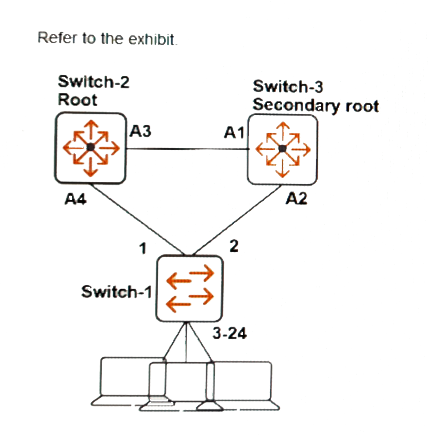
A network administrator wants to add the protections of root guard to the network. Based on the spanning tree topology, on which ports should the network administrator implement root guard?
- A. 3-24
- B. 1 and 2
- C. A1 and A2
- D. 2 and A3
Answer : C
Question 3
The implementation plan for AOS-Switches calls for them to implement port-based tunneled node. The Aruba Mobility Controllers that will support the AOS-
Switches run software 8.1. The controllers will also support APs, are managed by Mobility Master, and use clustering.
Which issue with this plan needs to be addressed?
- A. The controllers cannot support tunneled node with AOS-Switches when they are managed by the Mobility Master.
- B. The switches cannot connect to controllers that also support APs.
- C. The controllers must have their software updated before they can support the switches.
- D. The switches must use role-based tunneled node to work with clustering controllers.
Answer : A
Question 4
What is one difference between BPDU protection and root guard?
- A. BPDU protection works with RPVST+, RSTP, and MSTP. Root guard works with RSTP or MSTP, but not RPVST+.
- B. BPDU protection blocks a port if it receives any BPDU, but root guard blocks a port only if the BPDU indicates a better root path.
- C. BPDU protection is typically implemented on edge ports, but root guard is typically implemented on uplinks with the root port role.
- D. BPDU protection drops BPDUs received on a port, but does not block the port. Root guard blocks the port if it receives a BPDU.
Answer : B
Reference:
http://ericleahy.com/index.php/bpdu-guard-bpdu-filter-root-guard-loop-guard-udld/
Question 5
Refer to the exhibit.
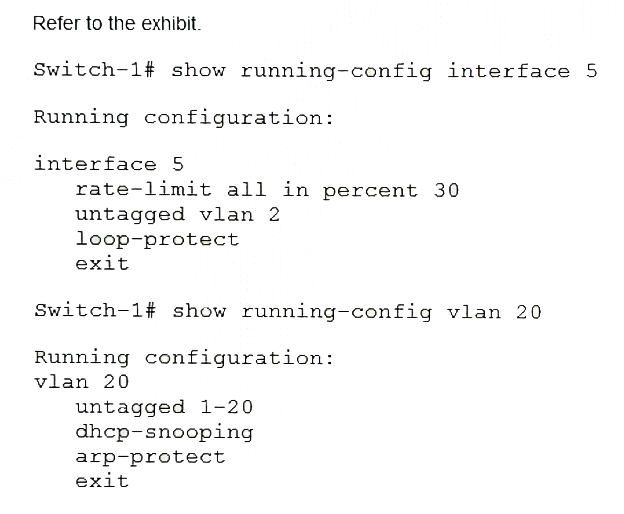
The exhibit shows configurations for interface 5 and VLAN 20. Note that DHCP snooping and ARP protection are also enabled.
A network administrator finds that interface 5 on an AOS-Switch is disabled. The administrator re-enables the interface, but it shuts down again. What should the administrator investigate?
- A. a device that sends too much unicast traffic
- B. rogue DHCP server
- C. a loop on the interface
- D. a device that sends unauthorized ARP messages
Answer : C
Question 6
Refer to the exhibit.
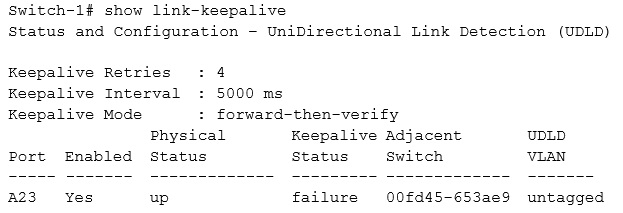
Switch-1 and Switch-2 connect on interface A23. The switches experience a connectivity issue. The network administrator sees that both switches show this interface as up. The administrator sees the output shown in the exhibit on Switch-1.
What is a typical issue that could cause this output?
- A. asymmetric routing introduced by a routing protocol
- B. an issue with VLAN mismatch
- C. mismatched subnet mask on the VLAN for the link
- D. a jumbo frame mismatch
Answer : A
Question 7
What is a reason to implement PIM-DM as opposed to PIM-SM?
- A. to control exactly which multicast groups are routed through the network
- B. to permit a higher density of RP routers in the network core
- C. to conserve bandwidth over WAN links
- D. to use on high-bandwidth routed connections
Answer : D
Question 8
An AOS-Switch enforces 802.1X. It receives an Access-Accept with this HPE VSA from its Radius server:
Attribute Name and ID = HPE-User-Role (25) Value = contractor
The switch then rejects the client. What is one requirement for the switch to accept the message and authorize the client?
- A. The initial user role must be set to the factory default permit any role.
- B. User role authorization must be enabled globally on the switch.
- C. An aaa authentication local user group must have the contractor name.
- D. The RADIUS server settings must permit dynamic authorization.
Answer : D
Question 9
Network administrators need to configure a BGP neighbor on an AOS-Switch. What defines the neighbor as an iBGP neighbor?
- A. It has BGP synchronization enabled.
- B. It has an AS number in the range of 64512 to 64535.
- C. Its update source is set to a private company IP address.
- D. Its remote-AS is the same as the AOS-Switch BGP AS.
Answer : D
Question 10
Refer to the exhibits.
Exhibit 1 -
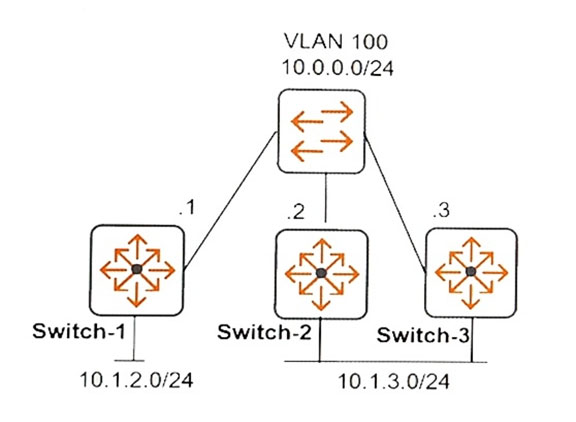
Exhibit 2 -

Exhibit 1 shows the topology for the network. The network administrator sees the log entries shown in Exhibit 2. Which type of failure is indicated?
- A. A link between Switch-1 and Switch-2 went down. BFD detected the lost connectivity and behaved as expected.
- B. Graceful restart helper was not enabled on Switch-2, so BFD was unable to operate correctly, and the session was taken down.
- C. A hardware issue caused a unidirectional link; BFD detected the issue at Layer 2 and prevented a broadcast storm.
- D. BFD was set up incorrectly on Switch-2, so it caused Switch-2 to lose adjacency with Switch-1 rather than repair the session.
Answer : D
Question 11
A company has AOS-switches, Aruba ClearPass, and Aruba AirWave. A network administrator needs to find the source of a performance issue that often occurs at the start of the day and early in the afternoon. Which action is likely to give the administrator the most useful information for the investigation?
- A. Access the Network Device view on ClearPass.
- B. Use the configuration audit tool on AirWave.
- C. View the current running config on each switch.
- D. View usage patterns on the switches on AirWave.
Answer : A
Question 12
Refer to the exhibits.
Exhibit 1 -
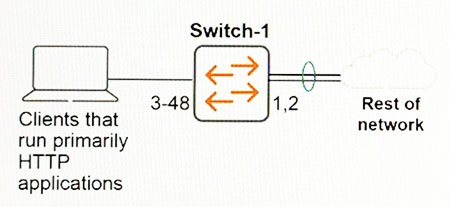
Exhibit 2 -
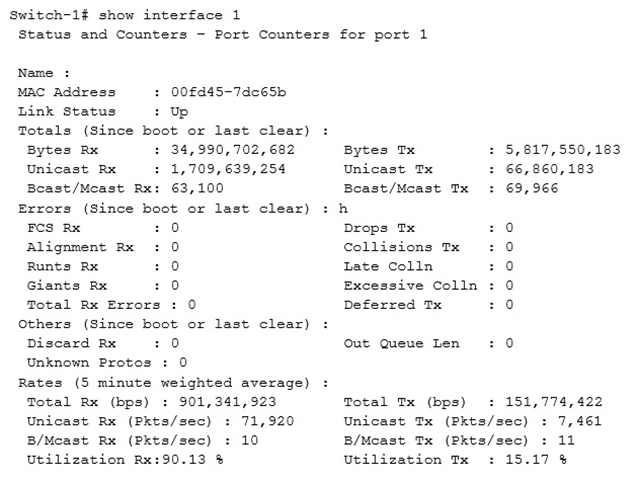
Network administrators are alerted to high interface utilization on a switch by a management solution. They examine the utilization on the uplink interfaces several times an hour during problem times. The exhibit shows output typical of times of congestion. The administrators want to allocate bandwidth fairly and reduce congestion on the uplinks.
What could help meet these requirements?
- A. a per-queue rate limit on interfaces 1 and 2
- B. an outbound rate limit on each edge port
- C. a broadcast rate limit on each edge port
- D. an outbound rate limit on interfaces 1 and 2
Answer : C
Question 13
Refer to the exhibit.
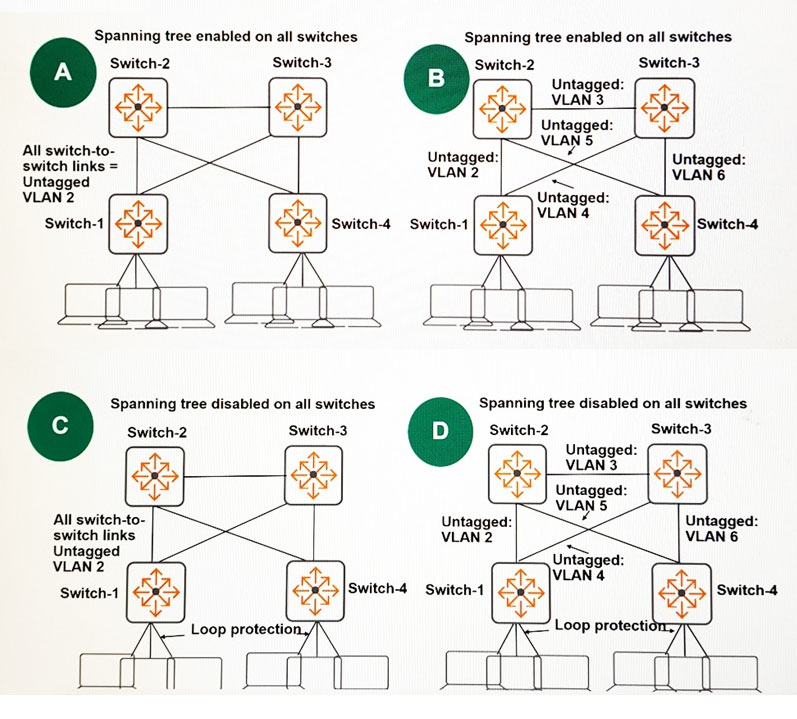
Every switch in the exhibit will route traffic. The company requires a topology in which failover for switch-to-switch links is exclusively handled by the routing protocol and occurs as quickly as possible. Which topology should the administrator use?
- A. A
- B. B
- C. C
- D. D
Answer : B
Question 14
Refer to the exhibit.

Switch-1 is an AOS-switch that is operating at factory default settings for QoS and has type of service disabled. It receives a frame with 802.1p value 5 on trk1, on
VLAN 2. How does the switch treat the frame when it forwards it on TRK2?
- A. It forwards it with higher than normal priority and 802.1p 0.
- B. It forwards it with normal priority and 802.1p 0.
- C. It forwards it with normal priority and 802.1p 5
- D. It forwards it with higher than normal priority and 802.1p 5.
Answer : B
Question 15
The security policy for a company requires that switches use SNMPv3 and accept all read-only SNMPv2c messages. The network administrator enables SNMPv3.
Which additional action should the network administrator take to comply with this policy?
- A. Disabled SNMPv3 inform timeouts.
- B. Enable SNMPv3 only operation.
- C. Enable SNMPv3 restricted mode.
- D. Disable SNMPv1/v2c.
Answer : C